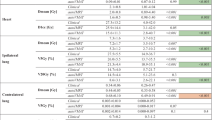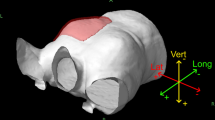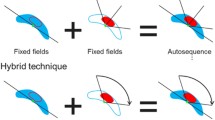Abstract
This study aimed to evaluate variations in dose distribution within the target volume and dose received by the organs at risk (OARs) for different tangential field arrangements during three-dimensional (3D) conformal treatment planning for left-sided breast cancer. Computed tomography (CT) images of 25 breast cancer patients were included, and three different mono-isocentric half-block (MIHB) treatment plans—parallel central axis technique (PCAXT), posterior border parallel technique (PBPT), and parallel quadrant technique (PQUDT)—were considered for each patient. The dosimetric and geometric parameters related to each followed plan were then extracted for the planning target volume (PTV) and the OARs, and compared. The results showed no significant differences among the extracted dosimetric and geometric parameters of the OARs for the different plans, while the Dmax, V95%, homogeneity index (HI), and conformity index (CI) values related to the PTV were significantly different (P < 0.05). The lowest Dmax and V95% values inside the PTV were related to the PCAXT plan. The best HI was achieved with the PBPT plan, whereas the best CI was observed for the PCAXT plan. The best correlation between the geometric and dosimetric parameters of the OARs was between V5Gy—central lung distance for the ipsilateral lung and the V5Gy—maximum heart distance for the heart in all plans. These results demonstrate that variations in the tangential field arrangement at the posterior border for optimal coverage of the PTV may not considerably affect the dose received by the OARs.









Similar content being viewed by others
References
DeSantis CE, Ma J, Gaudet MM, Newman LA, Miller KD, Goding Sauer A, et al. Breast cancer statistics, 2019. CA Cancer J Clin. 2019;69(6):438–51.
Azamjah N, Soltan-Zadeh Y, Zayeri F. Global trend of breast cancer mortality rate: a 25-year study. Asian Pac J Cancer Prev. 2019;20(7):2015.
Bray F, Ferlay J, Soerjomataram I, Siegel RL, Torre LA, Jemal A. Global cancer statistics 2018: GLOBOCAN estimates of incidence and mortality worldwide for 36 cancers in 185 countries. CA Cancer J Clin. 2018;68(6):394–424.
Hansen EK, Roach M. Handbook of evidence-based radiation oncology. Springer; 2010.
Brady LW, Perez CA, Wazer DE. Perez & Brady’s principles and practice of radiation oncology. Lippincott Williams & Wilkins; 2013.
Mansourian G, Robatjazi M, Baghani HR, Neshastehriz A, Mahdavi SR, Koosha F. Organ at risk dose calculation for left sided breast cancer treatments using intraoperative electron radiotherapy: a Monte Carlo-based feasibility study. Appl Radiat Isot. 2020;156:108977.
Castaneda SA, Strasser J. Updates in the treatment of breast cancer with radiotherapy. Surg Oncol Clin N Am. 2017;26(3):371–82.
Yang TJ, Ho AY. Radiation therapy in the management of breast cancer. Surg Clin North Am. 2013;93(2):455–71.
Finazzi T, Nguyen V-T, Zimmermann F, Papachristofilou A. Impact of patient and treatment characteristics on heart and lung dose in adjuvant radiotherapy for left-sided breast cancer. Radiat Oncol. 2019;14(1):153.
Allahverdi M, Nourollahi S, Esfahani M, Aghili M, Changizi V, Geraily G. Optimization of three dimensional planning dosimetric in breast phantom for match region of supraclavicular and tangential fields. J Cancer Res Ther. 2013;9(1):64.
Hernandez V, Arenas M, Pons F, Sempau J. Clinical applications of geometrical field matching in radiotherapy based on a new analytical solution. Med Dosim. 2011;36(2):160–5.
Romeo N. A new isocentric technique for exact geometric matching in the radiotherapy of the breast and ipsilateral supraclavicular fossa using dual asymmetric jaws. Phys Med. 2012;28(4):281–7.
Miles EA, Venables K, Hoskin PJ, Aird EG. Dosimetry and field matching for radiotherapy to the breast and supraclavicular fossa. Radiother Oncol. 2009;91(1):42–8.
Banaei A, Hashemi B, Bakhshandeh M. Comparing the monoisocentric and dual isocentric techniques in chest wall radiotherapy of mastectomy patients. J Appl Clin Med Phys. 2015;16(1):130–8.
Karimi AM, Tom MC, Manyam BV, Obi E, Tendulkar RD, Cherian S, et al. Evaluating improvements in cardiac dosimetry in breast radiotherapy and comparison of cardiac sparing techniques. J Radiat Oncol. 2019;8(3):305–10.
Darby SC, Ewertz M, McGale P, Bennet AM, Blom-Goldman U, Brønnum D, et al. Risk of ischemic heart disease in women after radiotherapy for breast cancer. New Engl J Med. 2013;368(11):987–98.
Drost L, Yee C, Lam H, Zhang L, Wronski M, McCann C, et al. A systematic review of heart dose in breast radiotherapy. Clin Breast Cancer. 2018;18(5):e819–24.
RTOG F. Breast cancer atlas. 2016. https://www.rtog.org/LinkClick.aspx?fileticket=vzJFhPaBipE%3d&tabid=236.
Gregoire V, Mackie T, Neve W. Prescribing, recording, and reporting photon-beam intensity-modulated radiation therapy (IMRT) (ICRU report 83). J ICRU. 2010. https://doi.org/10.1093/jicru/10.1.Report83.
Landberg T, Chavaudra J, Dobbs J, Gerard JP, Hanks G, Horiot JC, et al. Report 62. J ICRU. 1999. https://doi.org/10.1093/jicru_os32.1.48.
Ahmed RS, Jennifer F, Fiveash JB, Keene KS, Popple RA. An IMRT technique to increase therapeutic ratio of breast irradiation in patients with early-stage left breast cancer: limiting second malignancies. Med Dosim. 2008;33(1):71–7.
Yee C, Alayed Y, Drost L, Karam I, Vesprini D, McCann C, et al. Radiotherapy for patients with unresected locally advanced breast cancer. Ann Palliat Med. 2018;7(4):373–84.
Yi A, Kim HH, Shin HJ, Huh MO, Ahn SD, Seo BK. Radiation-induced complications after breast cancer radiation therapy: a pictorial review of multimodality imaging findings. Korean J Radiol. 2009;10(5):496–507.
Wallgren A. Late effects of radiotherapy in the treatment of breast cancer. Acta Oncol. 1992;31(2):237–42.
Brownlee Z, Garg R, Listo M, Zavitsanos P, Wazer DE, Huber KE. Late complications of radiation therapy for breast cancer: evolution in techniques and risk over time. Gland Surg. 2018;7(4):371–8.
Hurkmans CW, Borger JH, Bos LJ, van der Horst A, Pieters BR, Lebesque JV, et al. Cardiac and lung complication probabilities after breast cancer irradiation. Radiother Oncol. 2000;55(2):145–51.
Aznar MC, Duane FK, Darby SC, Wang Z, Taylor CW. Exposure of the lungs in breast cancer radiotherapy: a systematic review of lung doses published 2010–2015. Radiother Oncol. 2018;126(1):148–54.
Zhang Q, Liu J, Ao N, Yu H, Peng Y, Ou L, et al. Secondary cancer risk after radiation therapy for breast cancer with different radiotherapy techniques. Sci Rep. 2020;10(1):1–12.
Zurl B, Stranzl H, Winkler P, Kapp KS. Quantification of contralateral breast dose and risk estimate of radiation-induced contralateral breast cancer among young women using tangential fields and different modes of breathing. Int J Radiat Oncol Biol Phys. 2013;85(2):500–5.
Kong FM, Klein EE, Bradley JD, Mansur DB, Taylor ME, Perez CA, et al. The impact of central lung distance, maximal heart distance, and radiation technique on the volumetric dose of the lung and heart for intact breast radiation. Int J Radiat Oncol Biol Phys. 2002;54(3):963–71.
Onal C, Oymak E, Kotek A, Efe E, Arslan G. Correlation of conventional and conformal plan parameters for predicting radiation pneumonitis in patients treated with breast cancer. J Breast Cancer. 2012;15(3):320–8.
Ueda Y, Gerber NK, Das IJ. Model-based cardiac dose estimation in radiation treatment of left breast cancer. Br J Radiol. 2018;91(1090):20180287.
Walker V, Lairez O, Fondard O, Pathak A, Pinel B, Chevelle C, et al. Early detection of subclinical left ventricular dysfunction after breast cancer radiation therapy using speckle-tracking echocardiography: association between cardiac exposure and longitudinal strain reduction (BACCARAT study). Radiat Oncol. 2019;14(1):204.
Taylor C, Correa C, Duane FK, Aznar MC, Anderson SJ, Bergh J, et al. Estimating the risks of breast cancer radiotherapy: evidence from modern radiation doses to the lungs and heart and from previous randomized trials. J Clin Oncol. 2017;35(15):1641.
Author information
Authors and Affiliations
Corresponding author
Ethics declarations
Conflict of interest
The authors declare no conflicts of interest.
Ethical approval
For this type of study, formal consent was not required by our institution. This study did not involve participation by any human subjects.
Human and animal rights
This study received approval from the Institutional Review Board of the Sabzevar University of Medical Sciences. This study did not use any animal models.
Additional information
Publisher's Note
Springer Nature remains neutral with regard to jurisdictional claims in published maps and institutional affiliations.
About this article
Cite this article
Robatjazi, M., Baghani, H.R. & Porouhan, P. Dosimetric comparison between different tangential field arrangements during left-sided breast cancer radiotherapy. Radiol Phys Technol 14, 226–237 (2021). https://doi.org/10.1007/s12194-021-00621-7
Received:
Revised:
Accepted:
Published:
Issue Date:
DOI: https://doi.org/10.1007/s12194-021-00621-7




